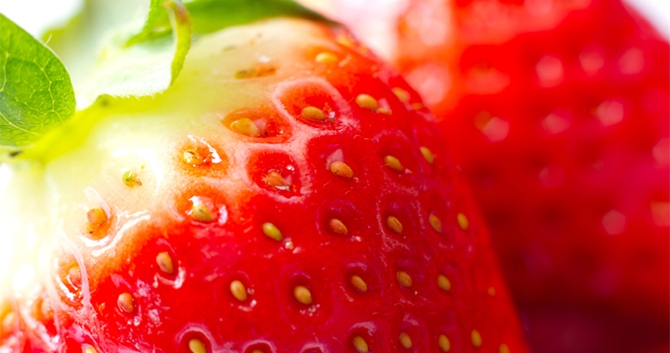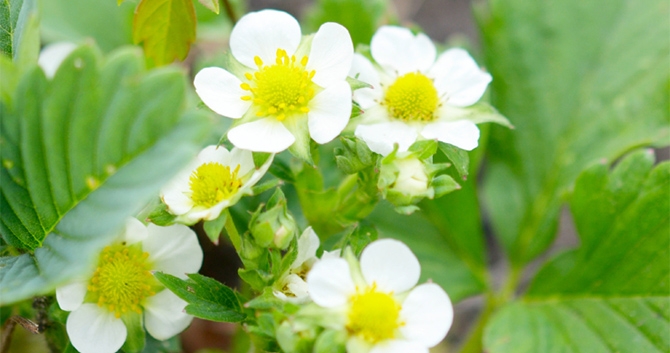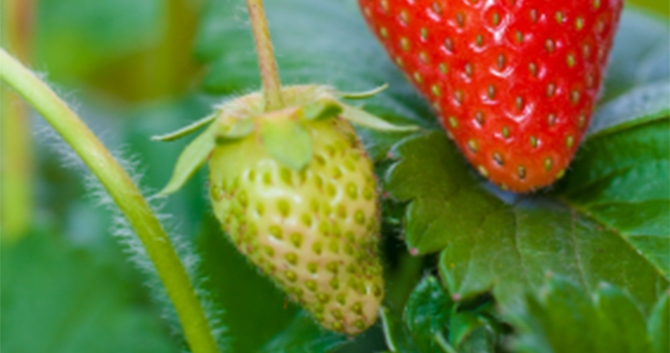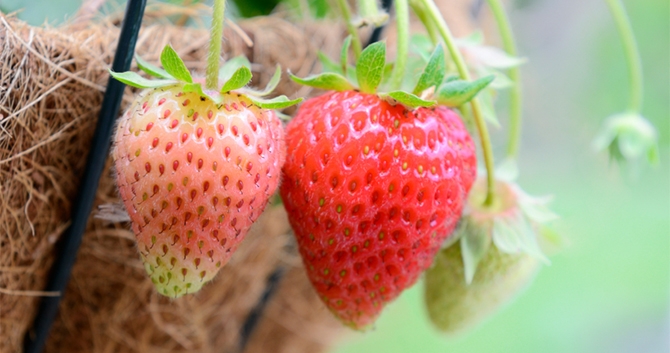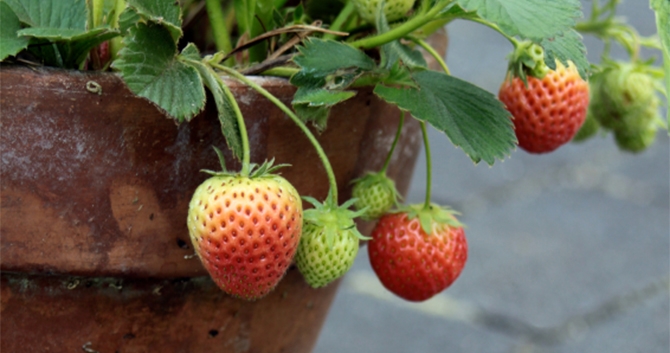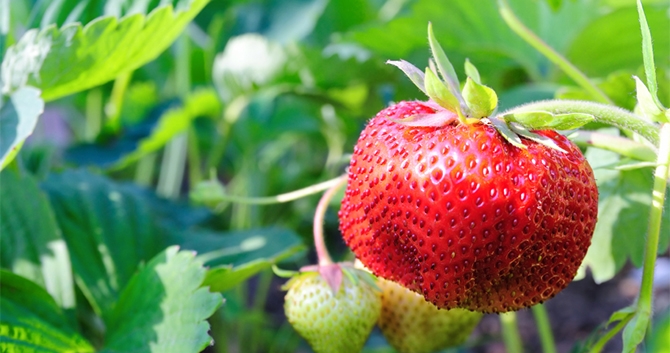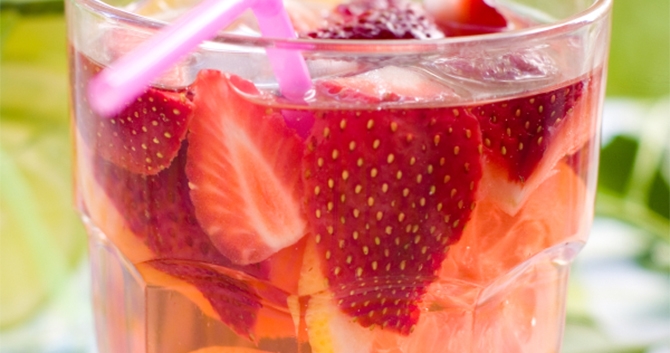Nothing puts a smile on your face like a strawberry! Whether you imagine summers at your grandparent’s house, strawberry picking, school lunches, eating chocolate covered strawberries, or enjoying a nice refreshing glass of strawberry lemonade, strawberries are one of nature’s true gems.
Incredibly sweet and juicy, they’re the most popular berry in the U.S. and a nutritionist’s dream! One serving of eight strawberries is higher in vitamin C than an orange and has as much potassium as half a banana. Strawberries are packed with lots of other vitamins and minerals, including calcium, thiamine, riboflavin, folic acid, nitrates, and 18 different amino acids. They are also about 90 percent water and very low in calories. With less than six calories each, you can indulge to your heart’s content without having to avoid the scale!
Strawberries are also high in antioxidants and beneficial for nerve function. Scientists are studying strawberries for their possible role in keeping cancer cells from multiplying, slowing the aging rate of the nervous system, and preventing and treating Alzheimer’s and other progressive nerve function loss.
History:
 Strawberries are the first fruit to ripen in the spring
Strawberries are the first fruit to ripen in the spring
Strawberries are native to both the northern and southern hemispheres, growing wild on every continent except Africa, Australia, and New Zealand. Historical records mention wild strawberries growing in Italy as far back as 234 B.C. Ancient Romans considered them a symbol of Venus, the goddess of beauty, love, and fertility, because of their red color and heart shape.
Strawberries fell out of favor in the Middle Ages, when Saint Hildegard von Binger pronounced them unfit to eat, claiming they were contaminated by toads and snakes because they grow so close to the ground. Charles Linnaeus, a Swedish botanist, put this superstition to rest in the mid-18th Century, by switching to a diet consisting only of strawberries to prove them edible.
From then on, the popularity of strawberries hasn’t missed a beat. Hybridizers lost no time in cross breeding strawberries from around the world to create distinctive flavors. One of the first hybrids, developed in France, created a pineapple flavored strawberry by crossing a Virginian variety and a Chilean variety.
Another big step forward for strawberries was in 1843, when growers in Cincinnati, Ohio first placed ice on top of boxes to keep them cool during shipping. Refrigerated shipping quickly expanded the market and increased the strawberry’s popularity. By 1860, strawberries were widely grown and enjoyed throughout much of the U. S.
Today, strawberries are cultivated worldwide including every state in the U.S., every province in Canada, all over Europe, Australia, and even Iran.
What’s in a Name?
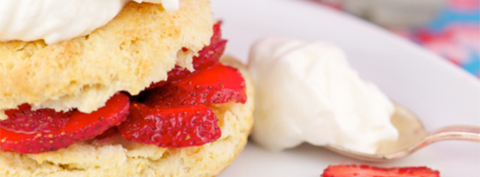 Strawberry shortcake traces its roots back to Native Americans
Strawberry shortcake traces its roots back to Native Americans
A rose by any other name… would be a strawberry! The strawberry is a member of the Rosacea (rose) family. Their botanical name (Fragaria) is Latin for “fragrance”. The French, Italian, and Spanish word for the fruit is "fraise" or fragrant berry. Narragansett Indians in North America called the fruit "wuttahimneash" or "heart berry”.
As for the name English name, “strawberry”, there are many views as to where it originated. Some attribute it to children in London who collected the berries, strung them on pieces of straw and sold them in the markets as "straws of berries." Others connect the name with the berry’s characteristic spreading habit, deriving from the Anglo-Saxon verb to strew (spread), the fruit came to be known as streabergen, straberry, streberie, straibery, straubery, and finally, to the English “strawberry”. Some claim the name originated over 1,000 years ago because of the runners which spread outward from the plant. It may also be derived from the straw placed around the growing plants for protection.
Regardless of its name, everyone can agree that strawberries are an iconic summer treat, perfectly snack sized and deliciously juicy and sweet.
Types:
There are over 200 varieties of strawberries worldwide, but essentially two major types - June Bearing and Everbearing or Day Neutral. Deciding which to plant depends on the amount of space you have and on your idea of the perfect strawberry.
If you haven’t grown strawberries before, consider this - commercially grown strawberries, although visually stunning, are bred for shipping and long shelf-life. They tend to have only half the sugar content of a traditional June bearer! If you want real strawberry flavor, try any of these types available at your local garden center:
June Bearing strawberries are large and sweet. They produce one large crop each year, lasting about two weeks in June or in early spring, depending upon your area. June bearing strawberries spread easily, putting out lots of runners so you’ll need space to let them grow. These are an ideal choice if you want an abundance to eat and preserve for the off-season.
Everbearing strawberries are sweet and petite. They have two to three smaller harvests, in June, late summer, and early fall. With few runners, they don’t need as much space and are great for hanging baskets and strawberry pots.
Day Neutral strawberries are an improved type of Everbearing, producing a more continuous crop of fruit as long as temperatures remain between 35 and 85 degrees. A great way to enjoy fresh, home-grown strawberries through the summer.
Specialty or Gourmet strawberries are relative newcomers to the scene, providing a constant display of larger, showy flowers in shades of pink or red as well as traditional white. Blooms are followed, of course, with fruit. Some varieties have large fruit, others may be smaller like a wild berry, but all will be exceptionally sweet and flavorful. Plants are ornamental and also provide a regular, small harvest you can enjoy almost daily. Specialty berries are normally grown in window boxes, hanging baskets or other containers, and displayed on the patio, deck or other sunny spot within easy reach.
Getting Started:
Whether you’re looking to make jam, a fresh summer desert or share with your children, sweet, juicy strawberries will bring happiness to your taste buds all harvest long. They will also be one of your favorite plants to grow and you’ll reap the benefits for years after your initial planting. Strawberries are hardy perennials in zones 4 through 8 and will return bigger and better than ever each year.
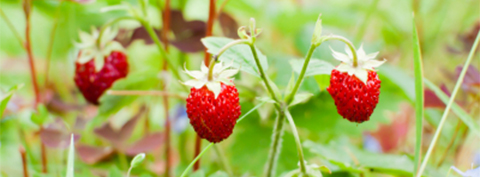 Everbearing and gourmet varieties are smaller and more like wild berries
Everbearing and gourmet varieties are smaller and more like wild berries
Strawberries are the first berries to ripen in the spring and a great way to kick-off the gardening season. Be sure to get your strawberry plants in the ground in early spring as soon as the soil is dry enough to work, to give them time to establish themselves before the summer heat. Choose a spot that gets at least six to eight hours of sun per day. Strawberries do best in rich, well-drained sandy soil.
Planting:
Set your strawberries out on a cloudy day or in the late afternoon to minimize the shock of transplanting. Prepare the soil in advance by removing weeds, tilling, and working in a balanced granular fertilizer at the rate recommended on the package. Space plants 12-18 inches apart with 3 to 4 feet between rows to provide space for the runners to expand. Cover the roots with soil, but leave the top of the crown exposed.
Watering:
Water the plants with 1 to 2 inches of water each week, in the absence of the equivalent in rain. For berries planted in containers, check the soil regularly and maintain consistent soil moisture.
Mulching:
Use clean straw to mulch around the plants, helping keep the soil cool and prevent weeds.
Pruning:
Once your strawberry plants are in the ground, the leaves and flower buds will grow quickly. For this first season, pinch off the early buds to help direct energy into the roots for a healthier plant. For Everbearing types, pinch off the flowers until July 1, then let them develop into fruit. For June Bearing strawberries, pinch all the flowers off the first year. This means you won’t get a crop the first year, but your patience will be repaid abundantly in the years to come.
Fertilizing:
After your strawberry patch is established, fertilize once a year, right after the first harvest of the season. A balanced, granular product is best, worked gently into the soil and watered well so that it does not sit on the leaves or crowns of the plants. Follow package instructions for the product you choose. Fertilize berries in containers weekly with a water soluble product formulated for fruits and vegetables.
Harvesting:
Pick strawberries when fruit is fully red, and leave the cap and a bit of stem on the fruit to help it stay fresh longer. Keep in a cool, shaded spot, and wait to rinse or wash them until just before you’re ready to eat them. Check plants every other day for more ripe fruit. Fruit will have the best quality if picked in the morning when cool.
Companion Plants:
Companion planting is the way to go when it comes to strawberries, especially if you have a small area to work with. Since strawberries need lots of space, surround the patch with your companions, or center them between the planted rows of berries, using the garden plot to your best advantage.
With a few well-chosen plants, you can also add essential nutrients to the soil and mask the scent of your strawberries from potential pests.
Several plants will improve growing conditions for your strawberries.
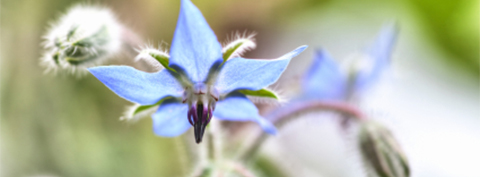 Borage is a great companion plant for strawberries, providing nutrients and attracting pollinators
Borage is a great companion plant for strawberries, providing nutrients and attracting pollinators
Borage is an herb that adds a mild cucumber taste to salads, soups, and other dishes. It improves soil richness by adding trace minerals, such as calcium and potassium. Borage also attracts beneficial insects like pollinators and predatory wasps that will keep pests away. Its pretty, blue, star-shaped blossoms add visual appeal, and this annual herb will re-seed freely to become a permanent resident in your garden. Just pull out any unwanted seedlings.
Caraway also attracts beneficial insects that will defend your strawberries against pests that would attack them!
Sage attracts important pollinators. It has an earthy aroma and soft green or variegated leaves and pale blue, pink or white flowers. Sage leaves are delicious with poultry, meat and vegetable dishes.
Strawberry plants stay low and spread horizontally, so good companions are those that grow vertically or fit in between your strawberries and mature before or after the fruits.
Peas and beans will grow up trellises or poles and add nitrogen to the soil.
Lettuce and spinach have shallow roots that will not interfere with strawberry runners. They also pair well with berries in a fresh spring salad.
Several companion plants will help deter pests that might otherwise destroy your strawberries. Try these in your garden plot:
Onions and chives will keep away aphids, weevils, spiders and nematodes. If you choose to include onions, unfortunately you will have to forego planting beans and peas in this garden as they will not prosper together.
Marigolds are the go-to plant of the fruit and vegetable garden. They deter nematodes and provide a visual splendor of orange, yellow or red blossoms. Marigolds also have a distinctive aroma that is pleasing to any gardener.
Note that some plants inhibit each other’s growth. Avoid planting these with your strawberries:
Peppers, tomatoes, eggplant, and potatoes can harbor verticillium wilt, a major strawberry disease.
Members of the cabbage family do not grow well with strawberries; these vegetables impair strawberry’s growth. Avoid planting broccoli, broccoflower, Brussels sprouts, cabbage, Chinese broccoli, cauliflower, collard greens, kale, kohlrabi, and Romanesco broccoli with your strawberries.
Winter Care: Strawberries are perennial in most regions, and with a little fall preparation you can enjoy your strawberry patch for many years. In cold winter climates, apply a loose layer of clean straw over the entire patch to insulate the strawberry crowns against frosts and freezing.
In spring when new growth resumes, remove the straw covering the plants. Tender flower buds are vulnerable to late frosts, so watch the weather forecast and re-cover if threatened. You may use a light frost cloth instead of the straw, especially for the early season back-and-forth.
 Marigolds are the go-to plant companion plant of the fruit and vegetable garden
Marigolds are the go-to plant companion plant of the fruit and vegetable garden
Troubleshooting:
Strawberries are generally pest-free and easy to grow, especially if they are kept weeded, inspected regularly and any signs of trouble treated promptly.
Birds love strawberries, and if they take more than you’re willing to share, use bird netting, predatory bird decoys or scare-away devices like sparkly pinwheels or streamers.
Blackened or undeveloped fruit can be caused by frost damage. Often plants will send up another round of flowers; take care to cover them if freezing weather threatens.
Fruit rot can be prevented with frequent harvest, and remove any spoiled or missed fruit that you find, to keep other fruit from being affected. Fertilizing in spring before the harvest can also result in soft fruit that does not keep well.
After several years, if yields are reduced, you may renovate the patch by removing the older, original plants and replacing with younger ones that have started from the runners.

